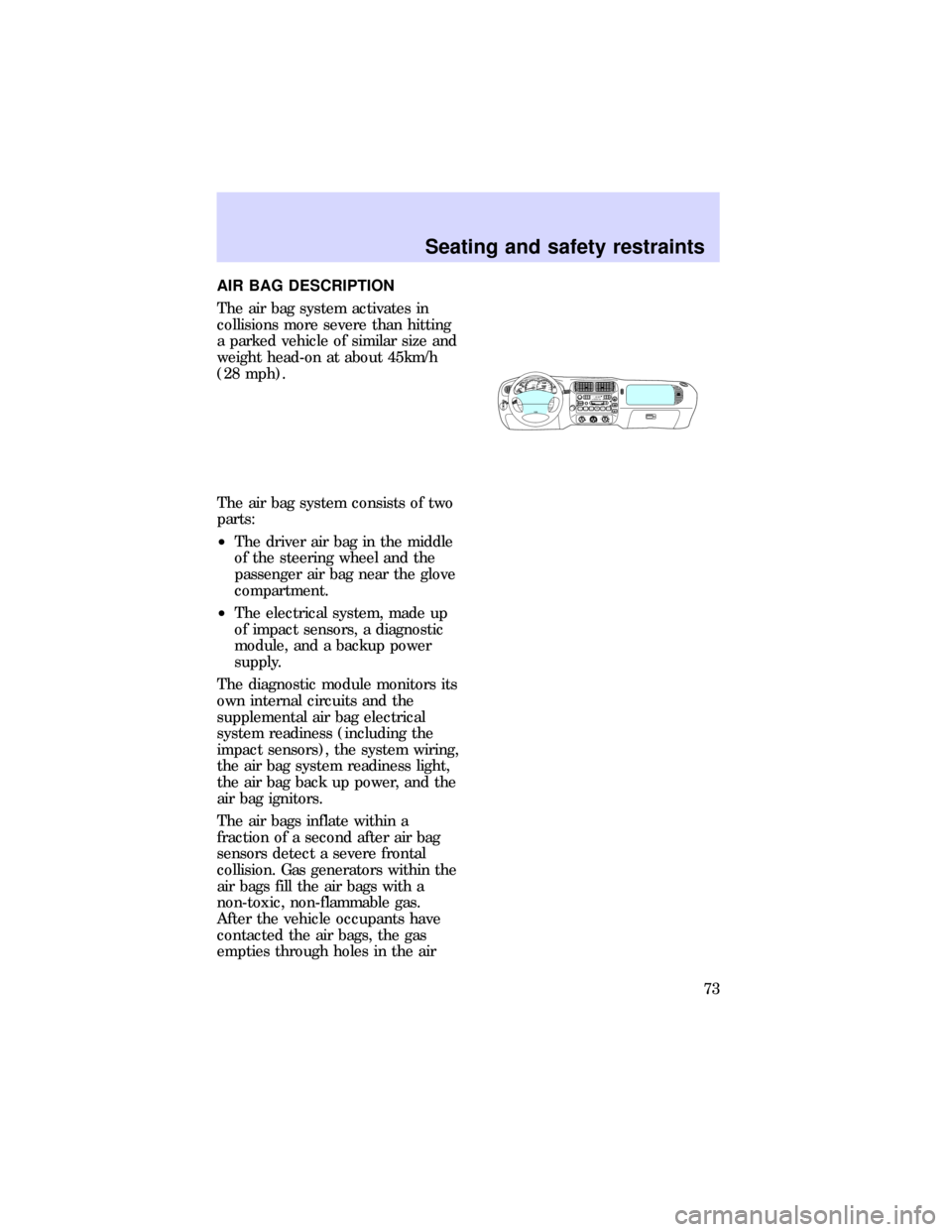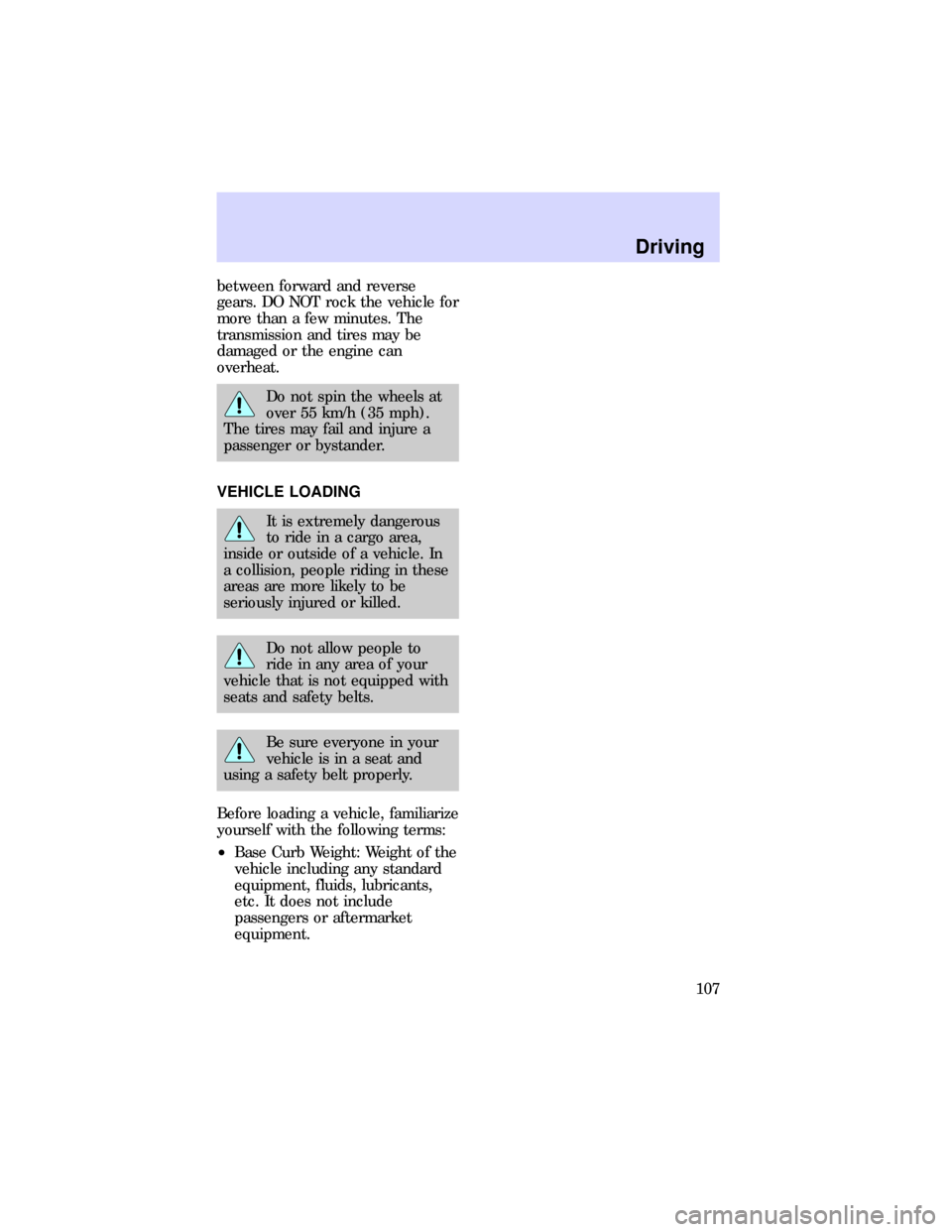weight Mercury Mountaineer 1997 Owner's Manuals
[x] Cancel search | Manufacturer: MERCURY, Model Year: 1997, Model line: Mountaineer, Model: Mercury Mountaineer 1997Pages: 197, PDF Size: 2.08 MB
Page 73 of 197

AIR BAG DESCRIPTION
The air bag system activates in
collisions more severe than hitting
a parked vehicle of similar size and
weight head-on at about 45km/h
(28 mph).
The air bag system consists of two
parts:
²The driver air bag in the middle
of the steering wheel and the
passenger air bag near the glove
compartment.
²The electrical system, made up
of impact sensors, a diagnostic
module, and a backup power
supply.
The diagnostic module monitors its
own internal circuits and the
supplemental air bag electrical
system readiness (including the
impact sensors), the system wiring,
the air bag system readiness light,
the air bag back up power, and the
air bag ignitors.
The air bags inflate within a
fraction of a second after air bag
sensors detect a severe frontal
collision. Gas generators within the
air bags fill the air bags with a
non-toxic, non-flammable gas.
After the vehicle occupants have
contacted the air bags, the gas
empties through holes in the air
EOFF0020406080100
120
140
160
180
200P RND21000000ooookm/hUNLEADED
FUEL ONLY
RPM x 100012345
6H
CEF
RSM
SET
ACC
COAST OFF ONOFFSRSHI LOOFF*A/C*MAX
A/CREW
1FF
2SIDE 1-2
3FM 1STVOL – PUSH ON
AM
FMBASS TREBBAL FADE
AUTO
SET CLKSEEKTUNE
DISCSSCAN4DOLBY SYSTEMEJTAPE CDCOMP
5SHUFFLE
6PUSH
Seating and safety restraints
73
Page 81 of 197

instruction underInstalling child
safety seats in combination lap
and shoulder belt seating
positionsin this chapter.
4. Hook the tether strap around
the webbing near the center of the
shoulder portion of the rear safety
belt and tighten.
BUILT-IN CHILD SEAT (IF
EQUIPPED)
The rear seat may include a
built-in child seat. This child seat
conforms to all federal and
Canadian motor vehicle safety
standards. Read the labels located
on the child seat cushion and
shoulder belt for information on
the built-in child seat.
Use the built-in child seatonly
under the following conditions:
Child's Age Child's Weight Child's Height
At least 1 year 10-27 kg (22-60 lb) Shoulders must be
below the shoulder
harness slots on the
built-in child seat
Children not meeting these
requirements should be secured in
an approved aftermarket child
seat. Refer toChildren and
infant or child safety seatsin this
chapter.
Seating and safety restraints
81
Page 107 of 197

between forward and reverse
gears. DO NOT rock the vehicle for
more than a few minutes. The
transmission and tires may be
damaged or the engine can
overheat.
Do not spin the wheels at
over 55 km/h (35 mph).
The tires may fail and injure a
passenger or bystander.
VEHICLE LOADING
It is extremely dangerous
to ride in a cargo area,
inside or outside of a vehicle. In
a collision, people riding in these
areas are more likely to be
seriously injured or killed.
Do not allow people to
ride in any area of your
vehicle that is not equipped with
seats and safety belts.
Be sure everyone in your
vehicle is in a seat and
using a safety belt properly.
Before loading a vehicle, familiarize
yourself with the following terms:
²Base Curb Weight: Weight of the
vehicle including any standard
equipment, fluids, lubricants,
etc. It does not include
passengers or aftermarket
equipment.
Driving
107
Page 108 of 197

²Payload: Combined maximum
allowable weight of cargo,
passengers and optional
equipment. The payload equals
gross vehicle weight rating
(GVWR) minus base curb
weight.
²GVW (Gross Vehicle Weight):
Base curb weight plus the
payload weight (including
passengers, cargo, and optional
equipment). Remember, the
GVW is not a limit or a
specification.
²GVWR (Gross Vehicle Weight
Rating): Maximum total weight
of the base vehicle, passengers,
optional equipment and cargo.
The GVWR is specific to each
particular vehicle and is listed
on the Safety Compliance
Certification Label on the
driver's door pillar.
²GAWR (Gross Axle Weight
Rating): Carrying capacity for
each axle system (front and
rear). This amount is specific to
each particular vehicle and is
listed on the Safety Compliance
Certification Label on the
driver's door pillar.
²GCWR (Gross Combined Weight
Rating): Maximum combined
weight of the towing vehicle
(including passengers and
cargo) and the trailer. The
GCWR indicates the maximum
loaded weight that the vehicle is
allowed to tow.
Driving
108
Page 109 of 197

²Maximum Trailer Weight Rating:
Maximum weight of a trailer the
vehicle is permitted to tow. The
maximum trailer weight rating
equals the vehicle curb weight
for each engine/transmission
combination, any required
option weight for trailer towing
and the weight of the driver
from the GCWR for the towing
vehicle.
²Maximum Trailer Weight:
Maximum weight of a trailer the
loaded vehicle (including
passengers and cargo) is
permitted to tow. It is
determined by subtracting the
weight of the loaded towing
vehicle from the GCWR for the
towing vehicle.
²Trailer Weight Range: Specified
weight range that the trailer
must fall within that ranges from
zero to the maximum trailer
weight rating.
Remember to figure in the tongue
load of your loaded trailer when
figuring the total weight.
If the GVWR or the GAWR
specified on the Safety
Compliance Certification Label is
exceeded, your vehicle may be
damaged or you may lose control
and injure someone.
To obtain correct weights, try
taking your vehicle to a shipping
company or an inspection station
for trucks.
Driving
109
Page 110 of 197

Do not use replacement tires with
lower weight capacities than the
original because they may lower
the vehicle's GVWR and GAWR
limitations. Replacement tires with
a higher weight limit than the
originals do not increase the
GVWR and GAWR limitations.
TRAILER TOWING
Your vehicle may tow a Class I or
II trailer provided the maximum
trailer weight is less than or equal
to the maximum trailer weight
listed for your engine and rear axle
ratio. See theTrailer towing table
later in this chapter.
Do not exceed the maximum loads
stated on the Safety Compliance
Certification Label. Refer to
Vehicle loadingfor a definition of
the terms on the label.
Your vehicle's load capacity is
designated by weight, not by
volume, so you cannot necessarily
use all available space when
loading a vehicle.
Distribute the trailer load so that
only 10 to 15% of the total weight
of the trailer is on the tongue. Tie
down the load so that it does not
shift and change the weight on the
hitch.
Towing a trailer places an
additional load on your vehicle's
engine, transmission, axle, brakes,
tires and suspension. Inspect these
components carefully before and
after any towing operation.
Driving
110
Page 111 of 197

If the GVWR or the GAWR
specified on the Safety
Compliance Certification Label is
exceeded, your vehicle may be
damaged or you may lose control
and injure someone.
Towing trailers beyond the
maximum recommended
gross trailer weight exceeds the
limits of the vehicle and could
result in engine damage,
transmission/axle damage,
structural damage, loss of
control, and personal injury.
Calculating the load your
vehicle can carry/tow
1. Use the Safety Compliance
Certification Label to find the axle
code number and engine type for
your vehicle.
2. Use the appropriate maximum
Gross Combined Weight Rating
(GCWR) chart to find the
maximum GCWR for your type
engine and rear axle ratio.
3. Weigh your vehicle as you
customarily operate the vehicle
without cargo. To obtain correct
weights, try taking your vehicle to
a shipping company or an
inspection station for trucks.
4. Subtract your loaded vehicle
weight from the maximum GCWR
on the following charts. This is the
maximum trailer weight your
vehicle can tow and must fall
Driving
111
Page 112 of 197

below the maximum shown under
maximum trailer weight on the
chart.
Trailer Towing Table
4R70W Automatic Transmission
EngineRear
Axle
RatioMaximum
GCWR kg (lb)
1
Maximum
Trailer Weight
kg (lb)
2
Maximum
Frontal Area of
Trailer ft
2-Wheel Drive
5.0L 3.73 4,990 (11,000) 3,039 (6,700) 50
All-Wheel Drive
5.0L 3.73 4,990 (11,000) 2,944 (6,500) 50
1For high altitude operation, reduce GCWR by 2% per 300 meters
(1,000 ft) elevation.
2To determine the maximum trailer weight designed for your particular
vehicle as equipped, follow the sectionCalculating the load your
vehicle can carry/towearlier in this section.
Preparing to tow
Use the proper equipment for
towing a trailer, and make sure it
is properly attached to your
vehicle. See your dealer or a
reliable trailer dealer if you require
assistance.
Hitches
Do not use or install hitches that
clamp onto the bumper or to the
axle. Underbody hitches are
acceptable if installed properly.
The rear bumper has an integral
hitch and only requires a ball with
a 3/4 inch shank diameter. The
Driving
112
Page 113 of 197

bumper has a Class II rating (1590
kg/3500 lb trailer weight and 159
kg/350 lb tongue weight).
Safety chains
Always connect the trailer's safety
chains to the vehicle. To connect
chains when towing with the step
bumper, cross the chains under the
trailer tongue and allow slack for
turning corners. Connect the
chains to the holes in the
underside of the hitch plate for a
Class II frame mounted hitch.
When using a frame mounted
trailer hitch, attach the safety
chains to the frame mounted hitch
using the recommendations
supplied by the hitch
manufacturer.
Trailer brakes
Trailer brakes are required on
most towed vehicles weighing over
680 kg/ 1500 lb. Use electric
brakes or manual, automatic, or
surge-type hydraulic brakes that
meet Federal and local regulations.
Install and adjust the brakes
according to the manufacturer's
instructions.
Do not connect a trailer's
hydraulic brake system
directly to your vehicle's brake
system. Your vehicle may not
have enough braking power and
your chances of having a
collision greatly increase.
Driving
113
Page 115 of 197

Servicing while towing
If you tow a trailer for long
distances, your vehicle will require
more frequent service intervals.
Refer to theService Guidefor
more information.
Trailer towing
²Practice turning, stopping and
backing in an area before
starting on a trip to get the feel
of the vehicle/trailer
combination. When turning,
drive slightly beyond the normal
turning point so the trailer
wheels will clear curbs and
other obstacles.
²Allow more room for stopping
with a trailer attached.
²The trailer tongue weight should
be 10-15% of the loaded trailer
weight for a Class I or II rear
bumper hitch.
²After you have travelled about
80 km (50 miles), thoroughly
check your hitch, electrical
connections and trailer wheel
lug nuts.
²When stopped in traffic for long
periods of time in hot weather,
place the gearshift in P (Park)
to increase idle speed. This aids
engine cooling and air
conditioner efficiency.
²Vehicles with trailers should not
be parked on a grade. If you
must park on a grade, place
wheel chocks under the trailer's
wheels.
Driving
115